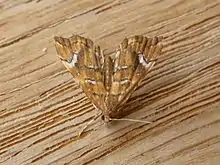Musotima nitidalis
Musotima nitidalis is a species of moth of the family Crambidae described by Francis Walker in 1866. It is native to Australia and New Zealand and was first found in Europe in 2009.
| Musotima nitidalis | |
|---|---|
 | |
| Scientific classification | |
| Kingdom: | |
| Phylum: | |
| Class: | |
| Order: | |
| Family: | |
| Genus: | |
| Species: | M. nitidalis |
| Binomial name | |
| Musotima nitidalis | |
| Synonyms | |
| |
Ecology
Adults are brown with various white markings outlined in black on each forewing.[2]
The larvae feed on the undersides of the leaves of various Polypodiophyta species, including Adiantum aethiopicum and Pteridium esculentum, living in a sparse web. They are pale green with a transparent skin. Pupation takes place in a folded leaf of the food plant, held by strands of white silk.
Distribution
It is known from New Zealand and most of Australia, including Queensland, Tasmania, Victoria, South Australia and Western Australia. In 2009 the moth was found in Dorset, England and since then has been found across southern England between Dorset and Essex. Larvae have been found in England and it is suspected to have been introduced from imported tree ferns.[3]
References
- "Australian Faunal Directory". Environment.gov.au. Retrieved 11 October 2011.
- "Musotima nitidalis (Walker, 1866)". Australian Caterpillars and their Butterflies and Moths. 8 September 2011. Retrieved 7 October 2019.
- Kimber, Ian. "63.1181 BF1355a Musotima nitidalis (Walker, [1866])". UKmoths. Retrieved 7 October 2019.